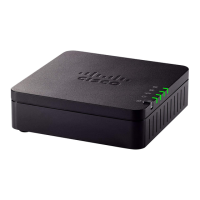DescriptionCodec
Very low complexity codecs that support
uncompressed 64 kbps digitized voice transmissions
at one through ten 5 ms voice frames per packet.
These codecs provide the highest narrow-band voice
quality and uses the most bandwidth of anyof the
available codecs.
G.726-32
ITU G.729 voice coding algorithm used to compress
digitized speech. G.729a is a reduced complexity
version of G.729 requiring about half the processing
power of G.729. The G.729 and G.729a bit streams
are compatible and interoperable, but not identical.
G.729a
SIP Proxy Redundancy
A typical SIP Proxy Server can handle thousands of subscribers. It is important that a backup server is available
so that an active server can be temporarily switched out for maintenance. The ATA supports the use of backup
SIP Proxy Servers (through DNS SRV) so that service disruption is minimized.
An easy way to support proxy redundancy is to configure your DNS server with a list of SIP proxy addresses.
The ATA can be instructed to contact a SIP Proxy Server in a domain named in the SIP message. The ATA
consults the DNS server to get a list of hosts in the given domain that provide SIP services. If an entry exists,
the DNS server returns an SRV record that contains a list of SIP Proxy Servers for the domain. This record
inclused such details as host names, priority, listening ports, and so on. The ATA tries to contact the list of
hosts in the order of their stated priority.
If the ATA is currently using a lower priority proxy server, it periodically probes the higher priority proxy to
see whether it is online, and switches back to the higher priority proxy when possible. You can use the default
settings or configure the Proxy Redundancy Method as described in the "Proxy and Registration" section of
this document.
Other ATA Voice Quality Features
Silence Suppression and Comfort Noise Generation
Voice Activity Detection (VAD) with Silence Suppression reduces the bandwidth needed for a single call,
making it possible for your network to support more calls overall. VAD distinguishes between speech and
non-speech signals, and Silence Suppression removes the natural silences that occur in a conversation. The
IP bandwidth is used only to transmit speech.
Comfort Noise Generation provides white noise when nobody is talking so you know that your call is still
connected.
Modem and Fax Pass-Through
The following applies to modem and fax pass-through:
Cisco ATA 191 and ATA 192 Analog Telephone Adapter Administration Guide for Multiplatform Firmware
7
Get Started
SIP Proxy Redundancy

